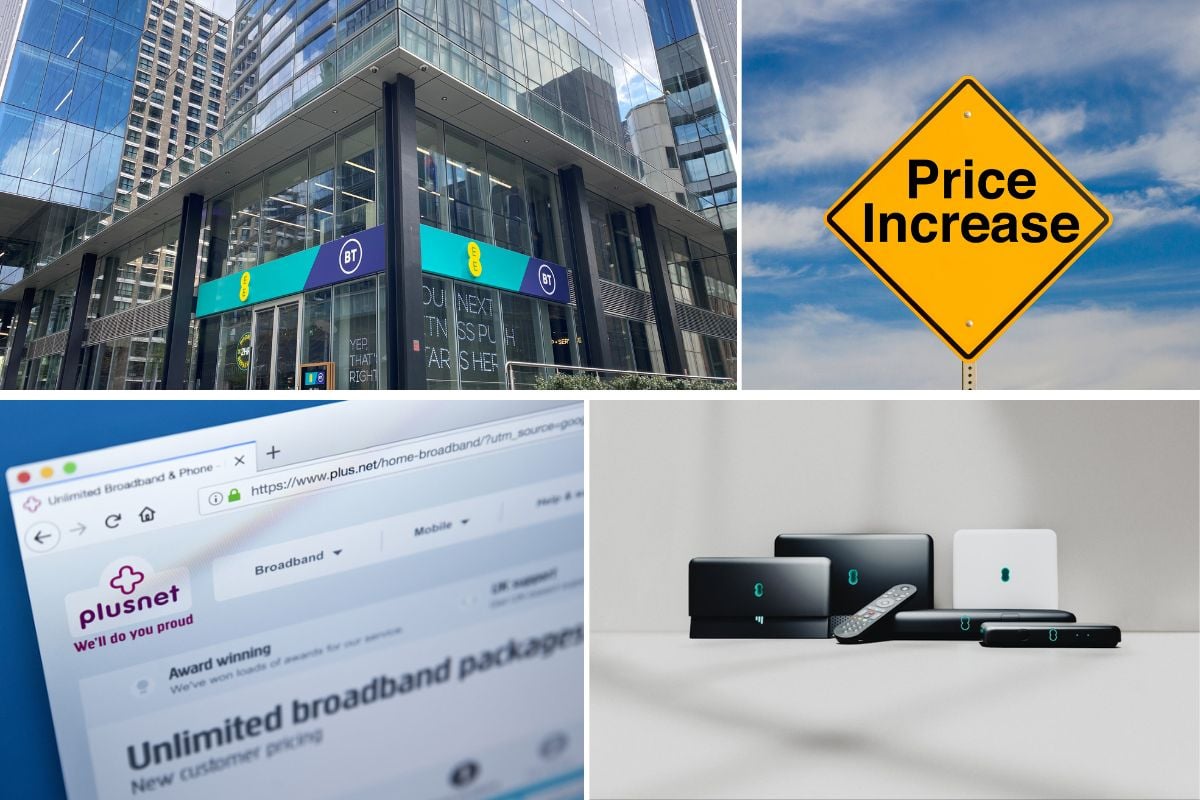BT, EE, and Plusnet are hiking their annual broadband price increases, making it more expensive to be a new customer.
Starting July 31 for BT and EE customers (August 5 for Plusnet), new broadband subscribers will face £4 monthly increases each March instead of the current £3.
That means if you sign up after these dates, you’ll be locked into paying an extra £12 per year compared to customers who signed up just days earlier (and paying £48 total annual increases instead of £36).
The change, first reported by ISPreview, affects anyone taking out new contracts or renewing existing ones after the cutoff dates.
Existing customers already under contract will stick with the lower £3 increases until they decide to switch deals.
While this might seem like a small bump, it represents a 33% increase in the annual price rise – and highlights how BT Group is testing the waters with higher mid-contract increases under Ofcom’s new pricing rules.
The Road to Transparent Pricing
To understand why BT can make these changes so easily, we need to rewind to Ofcom’s landmark decision from last year.

For years, broadband and TV customers were subjected to confusing annual price increases tied to inflation rates plus additional percentages.
You might sign up for a £45 package, only to see it jump to £49.77 the following year due to unpredictable CPI rates plus the provider’s own 3.9% surcharge.
This system left customers completely in the dark about future costs.
With inflation rates impossible to predict, there was no way to budget for next year’s bills – and since you were locked into contracts, you couldn’t escape no matter how steep the increases became.
Ofcom finally put an end to this practice in January 2025, banning inflation-linked price rises and requiring providers to spell out any future increases in pounds and pence at the point of sale.
Under the new regulations, providers must tell you upfront exactly how much your bill will increase each year, display this information as prominently as the initial price, and include all planned increases in your contract documents.
Sadly, the regulator didn’t ban mid-contract price increases entirely – they just demanded transparency about the amounts.
BT Group’s Early Adoption
BT Group (which owns BT, EE and Plusnet) was actually ahead of the curve on this one. Rather than wait for Ofcom’s January 2025 deadline, they implemented their new pricing model in April 2024.

From that point onwards, new BT, EE, and Plusnet customers were told exactly what their annual increases would be:
- EE Mobile customers: £1.50 per month increase
- EE TV customers: £2 per month increase
- BT/EE Broadband customers: £3 per month increase
This early move gave BT Group a head start in adapting to the new regulatory environment, and customers generally welcomed the clarity compared to the old inflation-plus-percentage system.
The company emphasised at the time that customers on social tariffs (EE Basics and BT Home Essentials) would remain exempt from any price increases, protecting vulnerable customers from additional financial pressure.
The New Reality: £4 Monthly Increases
Now, just over a year into their transparent pricing model, BT Group is already pushing the boundaries by increasing the broadband charge from £3 to £4 per month.
Here’s how it breaks down:
For existing customers already under contract: Your next price increase in March 2026 will still be £3 per month (assuming you haven’t renewed your contract by then).
For new customers signing up from July 31 (BT/EE) or August 5 (Plusnet): You’ll face £4 monthly increases on March 31st, 2026, and again on March 31, 2027.
For customers renewing contracts after these dates: You’ll also be moved onto the new £4 increase structure.
In response to these changes, a BT Consumer spokesperson told Cord Busters: “We are very supportive of Ofcom’s requirement to show upfront pounds and pence charges.
“EE was the first provider to introduce this pricing model, offering EE customers a predictable long-term view of their contract terms. Our pricing approach is designed to be clear for our customers.
“We continue to invest in our business, building on 11 years as the best network to better serve our customers with a reliable and quality connection as we roll out the fastest speed technology to 30m homes by the end of the decade.
“We’re focused on providing value and customer satisfaction, making new technologies available to our customers such as 5G standalone and WiFi 7.”
Why This Matters for TV Customers
Now, you might wonder why we’re covering broadband price increases on a site that usually focuses on TV and streaming. The answer is simple: if you want EE TV, you need BT or EE broadband.

The good news is that EE TV price increases remain unchanged at £2 per month each March. So if you’re getting both services, your total annual increase would be £6 per month (£4 for broadband, £2 for TV) rather than the previous £5.
This bundling requirement means TV customers can’t escape the broadband price increase by switching to a different provider while keeping their EE TV service. You’re essentially locked into both increases if you want the full package.
It’s worth noting that the £2 TV increase applies only to the base package, regardless of how many add-ons you have. So whether you’ve got just Entertainment or the full works with Sports and Cinema, your TV portion only goes up by £2 monthly.
How This Compares to Other Providers
BT Group’s price increase puts them slightly ahead of the competition in terms of annual broadband rises, though the market varies significantly.
Virgin Media currently implements £3.50 monthly increases across their broadband and TV bundles. They haven’t announced any changes to this structure yet, though that could change later in the year.
Sky operates differently, using percentage-based increases rather than fixed amounts. Their most recent rise was around 6.2% across services, though some Sky broadband customers can leave penalty-free when price increases are announced – a flexibility that BT customers don’t have.
The key difference is that Sky’s percentage approach means higher bills see larger absolute increases, while the fixed-amount system penalises smaller packages proportionally more.
On a £25 broadband package, a £4 increase represents 16% – considerably more than Sky’s recent percentage rises.
Was Ofcom’s Decision Actually Good for Consumers?
On paper, Ofcom’s ban on inflation-linked price rises seemed like a win for consumers. After all, who wouldn’t want to know exactly what they’ll be paying rather than crossing their fingers and hoping inflation stays low?
The transparency is genuinely helpful – there’s something to be said for being able to budget properly and avoid nasty surprises when your bill arrives.
Under the old system, you could sign up thinking you’d face modest increases, only to get walloped when inflation spiked unexpectedly.
When inflation runs high, the new pound-and-pence system can actually save you money. If we saw inflation hit 9% again (as it did in 2022), BT’s £4 annual increase would look pretty reasonable compared to the old “CPI plus 3.9%” formula that would have added much more to your bill.
But here’s the rub: BT’s decision to bump their broadband increases from £3 to £4 shows exactly what many critics feared would happen. Without the natural brake that inflation rates provided, companies are free to test how much they can get away with.

Think about it – under the old system, price increases were at least somewhat tied to economic reality. Now? It’s purely about what the market will tolerate.
So while you might avoid getting stung when inflation spikes, you’re potentially facing steady, predictable increases that could outpace inflation in calmer economic times.
And there’s nothing stopping BT from deciding that £5 monthly increases sound reasonable next year, then £6 the year after.
Where does it end? Well, that’s the million-pound question. In theory, competitive pressure should keep increases reasonable – customers can always switch when their contracts expire.
But with most major providers likely to follow similar patterns, the competitive element might not provide as much protection as we’d hope.
For more news and updates about TV and broadband, Subscribe to our free newsletter.

Batshit Bonkers Britain.
The place where British know they’re going to be ripped off.
Profit greedy companies valuing shareholders over customers.
When will someone protect us?
Whenever you see the name, Ofcom, be prepared to pay more, it’s all they do, simply protect the £billions of profit that companies make at the expense of the consumer. A good example of this is when the price cap is on the agenda, invariably it goes up, and the first thing the energy companies do, is offer way to save money by offering cheaper tariffs, probably through guilt.
Thats Ofgem.
You’re of course correct, I just got carried away with the anger bit.